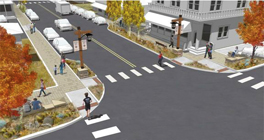
Community Works to Get Economy on Track
The City of Sisters faces challenges not unlike those in the well-known children’s book The Little Engine that Could.
The underlying theme is the same — a stranded train is unable to find an engine willing to take it over difficult terrain to its destination. Only the little blue engine is willing to try and, while repeating the mantra, I think I can, I think I can, overcomes a seemingly impossible task.
The City of Sisters has yet to find its little blue engine.
For about the past seven years the community has struggled to find the right mix of economic ‘drivers’ to sustain and grow the local economy. It may not be obvious to a passerby but the beautiful little town of about 2,000 people is working hard to find the right engine.
It hasn’t been going so well.
Brad Boyd is Sisters’ mayor. A longtime resident and small business owner, this is Boyd’s second (non-consecutive) term as mayor. “Historically Sisters has been a tourist town, especially since we stopped being a mill town and Black Butte Ranch was built in the ‘60s. Now we’re trying to stimulate ‘economic vitality’ in Sisters. Per capita income is down significantly, school enrollment is down and vacancies (retail and commercial spaces) are up.”
The irony is that Sisters’ small western town ambience is very obvious to anyone who has driven through the community.
“We serve as a gateway community to the natural beauty of Central Oregon. People love the easy access to our trail system for hiking, biking and horseback riding. And our special events like the Outdoor Quilt Show, the Sisters Rodeo and the Folk Festival draw thousands of visitors each year,” said Erin Borla, executive director of the Sisters Area Chamber of Commerce.
There are approximately 2,000 residents in the City of Sisters but the majority of Sisters Country residents (as defined by the school district boundary) reside in the surrounding residential communities. City figures estimate there are 8,000 full-time residents (including city residents) and 6,000 part-time.
Over the last seven years, including the year that the ‘Great Recession’ began (2007), Sisters’ city population has grown by approximately 16 percent. But on the down side, during that same period, per capita personal income of city residents plummeted from $38,655 in 2007 to $25,295. (City of Sisters data. Income includes pay from work outside Sisters.)
The Oregon Employment Department reports that the average annual pay for employees working for firms within the 97759 and 97730 zip codes (Sisters and Camp Sherman) was $28,910 in 2012. That’s down from $29,848 back in 2007. (This does not include the annual pay for people who live in Sisters Country but work in another town.)
There has also been a dramatic drop in school enrollment within the Sisters School District. From the 2007-08 school year to February 5, 2014 total enrollment has decreased 20 percent. And the District’s projections through the 2017-18 school year indicate another 25 percent decrease. That’s a total decrease of almost 40 percent from 2007 to 2018.
“The major reason for the decline in Sisters enrollment was the Great Recession’s affect on the housing market. Sisters was overly reliant on the housing market and many second homes were built here during the boom years of the early 2000s. As a result of this decline families could no longer make a living and stay in Sisters,” said Jim Golden, superintendent of the Sisters School District.
In 2007 the median sale price for a single family residence on one acre or less in Sisters was $407,000. There were 101 sales that year. In 2013 the same residence’s median sale price was $306,500 and there were 121 sales.
In comparison the median price for a single family residence in Bend was $267,000 in December of 2013. (Data provided by the Bratton Appraisal Group LLC.)
“A new school teacher can’t afford to live in our town,” said Robin Tawney, manager of the Sisters Area Habitat for Humanity ReStore.
The lack of living or family wage jobs in Sisters has been a key challenge for the City Council stretching back to the early 2000s. The City reported that the unemployment rate in Sisters was 9.7 percent in 2013. The State of Oregon ended the year at 7.0 percent.
During the early 1990s through the early 2000s there were companies in Sisters providing living and family wage jobs including Multnomah Publishers, Alpine Internet, NW Telemarketing, O’Keefe’s Working Hands Crème, Brand Navigation and Face Out Studio. Most of these firms have either relocated to other Central Oregon locations or were sold.
Companies remaining with sizeable employee counts include the Sisters School District, the U.S. Forest Service, Ray’s Food Place, Black Butte Ranch, Metabolic Maintenance and the much-publicized Energyneering, a new company located at the Sisters Airport providing renewable energy solutions.
The City Council and local nonprofit groups have engaged residents in trying to figure out and plan for an economically sustainable community. In 2006 about 250 residents spent a Saturday helping to create the Sisters Visioning Statement. Now framed and hanging in city hall, the statement was developed as a roadmap for city decision making.
Referring to economic development, the statement reads, “We have a strong tourism economy because of this beauty. But we are also a diversified entrepreneurial economy that includes arts and culture, light industry, natural resource-based businesses and small retail. This economy especially supports locally conceived and owned businesses that provide a wide variety of year-round family wage jobs.”
Sisters’ city government experienced a great deal of change in the eight years following the creation of the Visioning Statement. New city councilors, a new city manager, mayoral changes, several part-time economic development managers and a declining local economy have many residents wondering whether the Statement is worth the paper it’s printed on.
Mike Morgan is a retired high tech engineer who moved to Sisters in 2001. A well-known activist and member on the parks and recreation district board, Morgan is dismayed by the lack of economic progress. “I live out by the (Sisters) airport so I drive by the two newer industrial parks every day; they were there in 2001 and they are still vacant today except for one building.”
Looking back at Sisters’ past attempts to attract businesses to its Enterprise Zone, which includes the two industrial parkways and is part of the Greater Redmond Area Enterprise Zone,” Mayor Boyd is circumspect.
“Sisters hasn’t been successful in economic development when we’ve tried to compete as the low-cost option. We’re never going to have the least expensive land or space. We’re never going to compete with LaPine or Redmond. We need to be looking for individuals and small businesses that are looking for what we have – beautiful natural environment, strong schools, a great quality of life; that’s where we’re going to have success.”
As far back as 2002, in coordination with the now-dissolved Community Action Team of Sisters (CATS), the city developed and wrote an Economic Development Strategic Action Plan (EDSAP). Revised in 2005, 2009 and again in 2012 with the help of the Central Oregon Intergovernmental Council (COIC), the EDSAP was designed to outline specific action steps that targeted business sectors that made sense for the community.
Patti Cordoni, former economic development manager in Sisters, in a February 26, 2014 letter to the editor of The Nugget newspaper, questioned whether the latest update was being used. “(City) Council insisted on a revision and approved the CATS funds ($10,000) to be applied to the project. Open meetings were held with community members to target key items in each sector to help stimulate the economy in Sisters. And now… the Mayor calls an economic summit? What happened to the Strategic Action Plan (SAP) that the council insisted upon? Has anyone seen a finalized version of the SAP? He wants community input? Look at the SAP and finish it. Or was this exercise just another waste of resources and money?”
Cordoni is referring to the recent economic summit held on February 25. Called by Mayor Boyd after the city’s recently proposed amphitheater project ran into significant opposition, the goal was to give the community an opportunity to weigh in on the types of assets they do want.
In response to Cordoni’s assertion Mayor Boyd said, “The EDSAP plan was recently updated and we’ve got some ideas on it, it’s got some actionable items on it and we’re doing many of them.”
Prior to the February 25 economic summit meeting Mayor Boyd also said, “If the community doesn’t want an amphitheater that’s okay, what do you want? This is the time to be positive and contributing to what you do want, not what you don’t want, so we can move the community forward.”
City leaders have taken the brunt of criticism over the years for the lack of progress with economic development.
“Having sat on the city council for eight years, my term ended about a year ago; there was never a time where there was a positive impression of the city. There’s always been a lack of leadership in my opinion; meaning that we haven’t had a city government that’s willing to do the work and listen to the people about what they want our town to be,” said Sharlene Weed, executive director of the Sisters Area Habitat for Humanity.
It hasn’t helped that the city council and the city itself have received negative media publicity over the last few years. A longtime city manager resigned under pressure from the council. An outdoor food vendor is now suing the city alleging civil right violations, slander and defamation by city officials. City councilors are arguing with each other in local media and a recent proposal to build an amphitheater north of downtown, as well as convert the city’s campground to a more RV-friendly park, have met with a great deal of resident opposition.
It’s not unusual to hear people say that, “Sisters is not business friendly and not transparent with residents.”
“The mayor and the city manager (Andrew Gorayeb) have ideas about how they think things should run but really they’re not listening to the people – so we end up with people that are upset. It seems like they don’t understand that they’re running a democracy,” said Weed.
Mayor Boyd disputes those claims. “It’s easy to say ‘I didn’t get my way therefore you’re not business friendly’ but I would certainly refute that claim. The Sisters of 2014 is much more business friendly.”
“I’ve come to the conclusion that the town leadership had this vision, going back many years, that they could attract factory jobs and high tech jobs that pay a living wage and the reality is that it’s not going to happen. They should know that by now. Twelve years of having vacant lots ought to be enough to have that message sink in,” said Morgan.
From 2010 through early 2013 the City of Sisters directly contracted-out the role of economic development manager. Mac Hay first held the position, followed by Patti Cordoni, a local realtor. Sisters’ contract with each totaled $30,000 per year with no additional expense budget. Working in cooperation with Economic Development for Central Oregon (EDCO), both were tasked with attracting and retaining employers that could provide living wage jobs.
In 2013 the City Council, in coordination with EDCO, agreed that the economic development manager’s position should be under the EDCO umbrella, much the same as similar positions in Redmond, Prineville and Madras. Caprielle Foote-Lewis, a Sisters resident, was hired by EDCO in November 2013 as a three-quarter time independent contractor. She has an office in the Sisters City Hall.
“My primary function is to increase the base of locally-operated businesses that export a majority of their services and products outside the region and therefore bringing new dollars into Sisters. I’m also looking to increase the number of living wage and family wage jobs.”
Foote-Lewis understands the challenges that lie ahead. “One of the challenges is overcoming the stigma that Sisters is closed to opportunity. Quite the opposite, we are very open to opportunity. We have a new city council and a new city manager and, of course, my position. All of us are working hard to open Sisters Country up to opportunities, working with prospects, as well as helping existing companies stay and expand.”
In 2014 it’s beginning to look like the stranded train just might find its little blue engine to pull it into more prosperous times.
“I’m excited to share that we have a new company coming to town. Mohr Solutions Power is currently headquartered in Hillsboro but is relocating here. A growing and expanding company, they have high aspirations to create quite a number of family wage jobs,” said Foote-Lewis.
According to Foote-Lewis a Sisters-based tech space as well as an executive campus, utilizing existing hospitality resources, are being developed to increase the entrepreneurial spirit and culture within the community.
Trying to find ways to utilize existing vacant industrial parkway space is also a priority for Foote-Lewis now. “I’m looking for funding sources to build ‘incubators’ on our existing industrial park space. I’ve got several companies that want to be here but are concerned with the cost issues with our land. So if we can find a way to put some incubator flex space out there we can make that land productive and useful to the community.”
Morgan agrees that attracting the right professionals is a smart approach. “There are people in every high tech company that have the ability to dictate to their management where they’re going to work and where they’re going to play. We soon learn that if the wife and kids are happy where they live – people are less inclined to leave.”
Mayor Boyd, however, is quick to point out that economic development in Sisters has to include a multi-pronged approach.
“It’s not any one thing. It’s not just saying that we now have an EDCO manager going after traded sector employers with family wage jobs. It takes a tapestry of things to make a town economically viable. It also means ‘Are there community assets that we can create that make Sisters more attractive to both tourists and residents that make us a healthier community?”
One of the new assets that will improve both the tourist and resident experience is the Cascade Avenue Improvement Project which began on March 3. The main thoroughfare through town, the $6.6 million project, funded by both the city and the Oregon Department of Transportation, will replace the existing road and will include wider sidewalks and curb extensions. New landscaping and street lights should improve the community’s street appeal.
The economic development team in Sisters is optimistic about future investment in the community.
“If we’re successful we’re looking at potentially over $15 million in new capital investment in Sisters Country as well as potentially $9 million in wages,” said Foote-Lewis.
Sisters appears now to be saying I think I can, I think I can! just like the little blue engine. And with the involvement of informed and passionate residents the little town may just make it over the current difficult terrain to more prosperous times.





